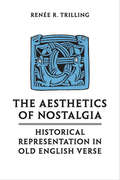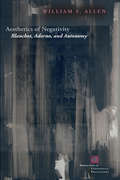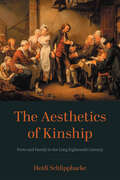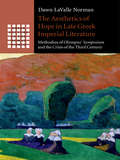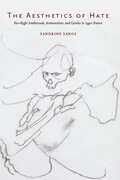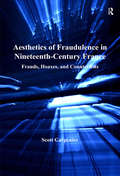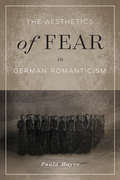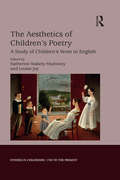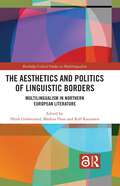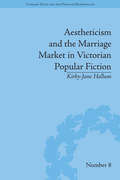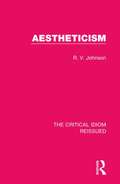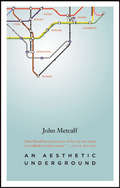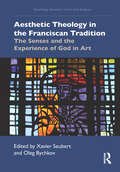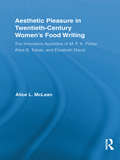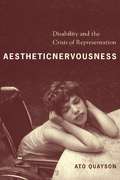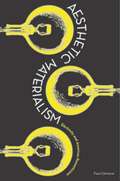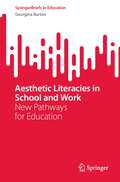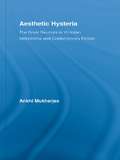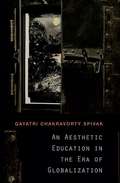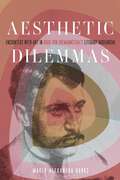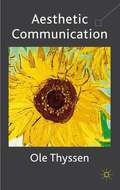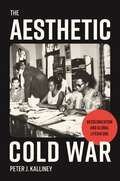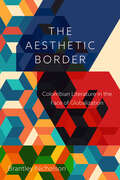- Table View
- List View
The Aesthetics of Nostalgia: Historical Representation in Old English Verse
by Renee R. TrillingHeroic poetry was central to the construction of Anglo-Saxon values, beliefs, and community identity and its subject matter is often analyzed as a window into Anglo-Saxon life. However, these poems are works of art as well as vehicles for ideology. Aesthetics of Nostalgia reads Anglo-Saxon historical verse in terms of how its aesthetic form interacted with the culture and politics of the period. Examining the distinctive poetic techniques found in vernacular historic poetry, Renée R. Trilling argues that the literary construction of heroic poetry promoted specific kinds of historical understanding in early medieval England, distinct from linear and teleological perceptions of the past. The Aesthetics of Nostalgia surveys Anglo-Saxon literary culture from the age of Bede to the decades following the Norman Conquest in order to explore its cultural impact through both its content and its form.
Aesthetics of Negativity: Blanchot, Adorno, and Autonomy
by William S. AllenMaurice Blanchot and Theodor W. Adorno are among the most difficult but also the most profound thinkers in twentieth-century aesthetics. While their methods and perspectives differ widely, they share a concern with the negativity of the artwork conceived in terms of either its experience and possibility or its critical expression. Such negativity is neither nihilistic nor pessimistic but concerns the status of the artwork and its autonomy in relation to its context or its experience. For both Blanchot and Adorno negativity is the key to understanding the status of the artwork in post-Kantian aesthetics and, although it indicates how art expresses critical possibilities, albeit negatively, it also shows that art bears an irreducible ambiguity such that its meaning can always negate itself. This ambiguity takes on an added material significance when considered in relation to language as the negativity of the work becomes aesthetic in the further sense of being both sensible and experimental, and in doing so the language of the literary work becomes a form of thinking that enables materiality to be thought in its ambiguity. In a series of rich and compelling readings, William S. Allen shows how an original and rigorous mode of thinking arises within Blanchot’s early writings and how Adorno’s aesthetics depends on a relation between language and materiality that has been widely overlooked. Furthermore, by reconsidering the problem of the autonomous work of art in terms of literature, a central issue in modernist aesthetics is given a greater critical and material relevance as a mode of thinking that is abstract and concrete, rigorous and ambiguous. While examples of this kind of writing can be found in the works of Blanchot and Beckett, the demands that such texts place on readers only confirm the challenges and the possibilities that literary autonomy poses to thought.
The Aesthetics of Kinship: Form and Family in the Long Eighteenth Century (New Studies in the Age of Goethe)
by Heidi SchlipphackeThe Aesthetics of Kinship intervenes critically into rigidified discourses about the emergence of the nuclear family and the corresponding interior subject in the eighteenth century. By focusing on kinship constellations instead of “family plots” in seminal literary works of the period, this book presents an alternative view of the eighteenth-century literary social world and its concomitant ideologies. Whereas Enlightenment and post-Enlightenment philosophy and political theory posit the nuclear family as a microcosm for the ideal modern nation-state, literature of the period offers a far more heterogeneous image of kinship structures, one that includes members of various classes and is not defined by blood. Through a radical re-reading of the multifarious kinship structures represented in literature of the long eighteenth century, The Aesthetics of Kinship questions the inevitability of the dialectic of the Enlightenment and invokes alternative futures for conceptions of social and political life.
The Aesthetics of Hope in Late Greek Imperial Literature: Methodius of Olympus' Symposium and the Crisis of the Third Century (Greek Culture in the Roman World)
by Dawn LaValle NormanThis book sheds light on a relatively dark period of literary history, the late third century CE, a period that falls between the Second Sophistic and Late Antiquity. It argues that more was being written during this time than past scholars have realized and takes as its prime example the understudied Christian writer Methodius of Olympus. Among his many works, this book focuses on his dialogic Symposium, a text which exposes an era's new concern to re-orient the gaze of a generation from the past onto the future. Dr LaValle Norman makes the further argument that scholarship on the Imperial period that does not include Christian writers within its purview misses the richness of this period, which was one of deepening interaction between Christian and non-Christian writers. Only through recovering this conversation can we understand the transitional period that led to the rise of Constantine.
The Aesthetics of Hate: Far-Right Intellectuals, Antisemitism, and Gender in 1930s France
by Sandrine SanosThe Aesthetics of Hate examines the writings of a motley collection of interwar far-right French intellectuals, showing that they defined Frenchness in racial, gendered, and sexual terms.
Aesthetics of Fraudulence in Nineteenth-Century France: Frauds, Hoaxes, and Counterfeits
by Scott CarpenterIn his engagingly written and original book, Scott Carpenter analyzes multiple manifestations of the false in nineteenth-century France. Under Carpenter's thorough and systematic analysis, fraudulence emerges as a cultural preoccupation in nineteenth-century literature and society, whether it be in the form of literary mystifications, the thematic portrayal of frauds, or the privileging of falseness as an aesthetic principle. Focusing particularly on the aesthetics of fraudulence in works by Mérimée, Balzac, Baudelaire, Vidocq, Sand, and others, Carpenter places these literary representations within the context of other cultural phenomena, such as caricature, political history, and ceremonial events. As he highlights the special relationship between literary fiction and fraudulence, Carpenter argues that falseness arises as an aesthetic preoccupation in post-revolutionary France, where it introduces a blurring of limits between hitherto discrete categories. This transgression of boundaries challenges notions of authenticity and sincerity, categories that Romantic aesthetics championed at the beginning of the nineteenth century in France. Carpenter's study makes an important contribution to the cultural significance of mystification in nineteenth-century France and furthers our understanding of French literature and cultural history.
The Aesthetics of Fear in German Romanticism (McGill-Queen's Studies in the History of Ideas #77)
by Paola MayerEnlightenment – both the phenomenon specific to the eighteenth century and the continuing trend in Western thought – is an attempt to dispel ignorance, achieve mastery of a potentially hostile environment, and contain fear of the unknown by promoting science and rationality. Enlightenment is often accompanied and challenged by countercultures such as German Romanticism, which explored the nature of fear and deployed it as a corrective to the excesses of rationalism. The Aesthetics of Fear in German Romanticism uncovers the formative role this movement played in the development of dark or negative aesthetics. Recovering a missing chapter in the history of the aesthetics of fear, Paola Mayer illustrates that Romanticism was a crucial transitional phase between the eighteenth-century sublime and the early twentieth-century uncanny. Mayer puts literature and philosophy in dialogue, examining how German Romantic literature employed narratives of fear to radicalize and then subvert the status quo in society, culture, and science. She traces the development of this aesthetic from its inception with pre-Romantics such as Jean Paul Richter to its end in Joseph von Eichendorff's critical retrospective, and juxtaposes canonical authors such as E.T.A. Hoffmann – the father of the modern fantastic – with writers who have previously been ignored. Today, when the dark side of science looms in the foreground, The Aesthetics of Fear in German Romanticism points to the power of a literary movement to construct competing currents of thought.
The Aesthetics of Children's Poetry: A Study of Children's Verse in English (Studies in Childhood, 1700 to the Present)
by Katherine Wakely-Mulroney Louise JoyThis collection gives sustained attention to the literary dimensions of children’s poetry from the eighteenth century to the present. While reasserting the importance of well-known voices, such as those of Isaac Watts, William Blake, Lewis Carroll, Christina Rossetti, A. A. Milne, and Carol Ann Duffy, the contributors also reflect on the aesthetic significance of landmark works by less frequently celebrated figures such as Richard Johnson, Ann and Jane Taylor, Cecil Frances Alexander and Michael Rosen. Scholarly treatment of children’s poetry has tended to focus on its publication history rather than to explore what comprises – and why we delight in – its idiosyncratic pleasures. And yet arguments about how and why poetic language might appeal to the child are embroiled in the history of children’s poetry, whether in Isaac Watts emphasising the didactic efficacy of “like sounds,” William Blake and the Taylor sisters revelling in the beauty of semantic ambiguity, or the authors of nonsense verse jettisoning sense to thrill their readers with the sheer music of poetry. Alive to the ways in which recent debates both echo and repudiate those conducted in earlier periods, The Aesthetics of Children’s Poetry investigates the stylistic and formal means through which children’s poetry, in theory and in practice, negotiates the complicated demands we have made of it through the ages.
The Aesthetics and Politics of Linguistic Borders: Multilingualism in Northern European Literature (Routledge Critical Studies in Multilingualism)
by Heidi Grönstrand Markus Huss Ralf KauranenThis collection showcases a multivalent approach to the study of literary multilingualism, embodied in contemporary Nordic literature. While previous approaches to literary multilingualism have tended to take a textual or authorship focus, this book advocates for a theoretical perspective which reflects the multiplicity of languages in use in contemporary literature emerging from increased globalization and transnational interaction. Drawing on a multimodal range of examples from contemporary Nordic literature, these eighteen chapters illustrate the ways in which multilingualism is dynamic rather than fixed, resulting from the interactions between authors, texts, and readers as well as between literary and socio-political institutions. The book highlights the processes by which borders are formed within the production, circulation, and reception of literature and in turn, the impact of these borders on issues around cultural, linguistic, and national belonging. Introducing an innovative approach to the study of multilingualism in literature, this collection will be of particular interest to students and researchers in literary studies, cultural studies, and multilingualism.
The Aesthetics and Politics of Linguistic Borders: Multilingualism in Northern European Literature (ISSN)
by Markus Huss Ralf KauranenThis collection showcases a multivalent approach to the study of literary multilingualism, embodied in contemporary Nordic literature. While previous approaches to literary multilingualism have tended to take a textual or authorship focus, this book advocates for a theoretical perspective which reflects the multiplicity of languages in use in contemporary literature emerging from increased globalization and transnational interaction. Drawing on a multimodal range of examples from contemporary Nordic literature, these eighteen chapters illustrate the ways in which multilingualism is dynamic rather than fixed, resulting from the interactions between authors, texts, and readers as well as between literary and socio-political institutions. The book highlights the processes by which borders are formed within the production, circulation, and reception of literature and in turn, the impact of these borders on issues around cultural, linguistic, and national belonging. Introducing an innovative approach to the study of multilingualism in literature, this collection will be of particular interest to students and researchers in literary studies, cultural studies, and multilingualism.
Aestheticism and the Marriage Market in Victorian Popular Fiction: The Art of Female Beauty (Literary Texts and the Popular Marketplace #8)
by Kirby-Jane HallumBased on close readings of five Victorian novels, Hallum presents an original study of the interaction between popular fiction, the marriage market and the aesthetic movement. She uses the texts to trace the development of aestheticism, examining the differences between the authors, including their approach, style and gender.
Aestheticism (The Critical Idiom Reissued #3)
by R. V. JohnsonFirst published in 1969, this work explores aestheticism and its relationship with literature. After defining the term and examining the unique qualities of ‘the Aesthetes’, the book provides an overview of the literary movement from its emergence to its apotheosis in the 1890s. This book will be of particular interest to those studying 19th Century literature.
An Aesthetic Underground
by John Metcalf"John Metcalf has written some of the very best stories ever published in this country."--Alice MunroThe Argus-eyed editor; the magisterial prose stylist; the waggish, inflammatory cultural critic; the mentor and iconoclast. John Metcalf is a literary legend whose memoir maps the underground he labored tirelessly to establish.
Aesthetic Theology in the Franciscan Tradition: The Senses and the Experience of God in Art (Routledge Research in Art and Religion)
by Xavier Seubert Oleg BychkovThe book investigates the aesthetic theology embedded in the Franciscan artistic tradition. The novelty of the approach is in applying concepts gleaned from Franciscan textual sources to create a deeper understanding of how art in all its sensual forms was foundational to the Franciscan milieu. Chapters range from studies of statements about aesthetics and the arts in theological textual sources to examples of visual, auditory, and tactile arts communicating theological ideas found in texts. The essays cover not only European art and textual sources, but also Franciscan influences in the Americas found in both texts and artifacts.
Aesthetic Poetry
by Walter PaterTHE "aesthetic" poetry is neither a mere reproduction of Greek or medieval poetry, nor only an idealisation of modern life and sentiment. <P> <P> The atmosphere on which its effect depends belongs to no simple form of poetry, no actual form of life. Greek poetry, medieval or modern poetry, projects, above the realities of its time, a world in which the forms of things are transfigured. Of that transfigured world this new poetry takes possession, and sublimates beyond it another still fainter and more spectral, which is literally an artificial or "earthly paradise."
Aesthetic Pleasure in Twentieth-Century Women's Food Writing: The Innovative Appetites of M.F.K. Fisher, Alice B. Toklas, and Elizabeth David (Routledge Studies in Twentieth-Century Literature)
by Alice McLeanThis book explores the aesthetic pleasures of eating and writing in the lives of M. F. K. Fisher (1908-1992), Alice B. Toklas (1877-1967), and Elizabeth David (1913-1992). Growing up during a time when women's food writing was largely limited to the domestic cookbook, which helped to codify the guidelines of middle class domesticity, Fisher, Toklas, and David claimed the pleasures of gastronomy previously reserved for men. Articulating a language through which female desire is artfully and publicly sated, Fisher, Toklas, and David expanded women’s food writing beyond the domestic realm by pioneering forms of self-expression that celebrate female appetite for pleasure and for culinary adventure. In so doing, they illuminate the power of genre-bending food writing to transgress and reconfigure conventional gender ideologies. For these women, food encouraged a sensory engagement with their environment and a physical receptivity toward pleasure that engendered their creative aesthetic.
Aesthetic Nervousness: Disability and the Crisis of Representation
by Ato QuaysonFocusing primarily on the work of Samuel Beckett, Toni Morrison, Wole Soyinka, and J. M. Coetzee, Ato Quayson launches a thoroughly cross-cultural, interdisciplinary study of the representation of physical disability. Quayson suggests that the subliminal unease and moral panic invoked by the disabled is refracted within the structures of literature and literary discourse itself, a crisis he terms "aesthetic nervousness." The disabled reminds the able-bodied that the body is provisional and temporary and that normality is wrapped up in certain social frameworks. Quayson expands his argument by turning to Greek and Yoruba writings, African American and postcolonial literature, depictions of deformed characters in early modern England and the plays of Shakespeare, and children's films, among other texts. He considers how disability affects interpersonal relationships and forces the character and the reader to take an ethical standpoint, much like representations of violence, pain, and the sacred. The disabled are also used to represent social suffering, inadvertently obscuring their true hardships.
Aesthetic Materialism
by Paul GilmoreWalt Whitman's "Sing the Body Electric" metaphor from his epic Leaves of Grass poem stems from the technology of the time, according to Gilmore (English, California State U. , Long Beach). After tracing the term "aesthetics" back to Elizabeth Peabody's Aesthetic Papers (1849), he analyzes aesthetic images of electricity, the telegraph, and other technological developments from earlier British Romanticism to those of American Romantic writers including Whitman, Herman Melville, and Frederick Douglass. Portions of the chapter on Douglass were originally printed in a 2002 issue of the literary journal ATQ. Annotation ©2009 Book News, Inc. , Portland, OR (booknews. com)
Aesthetic Literacies in School and Work: New Pathways for Education (SpringerBriefs in Education)
by Georgina BartonThis book argues the importance of aesthetic literacies in learning and teaching in schools for future work. The study of aesthetics is critical in today’s learning, due to the increasingly complex ways in which we communicate meaning, such as through the presentation of texts and objects. The book provides educators, pre-service teachers, and students an in-depth understanding of aesthetic literacies in innovative spaces, including in philosophical literature, environmental spaces, curricula and classrooms. Using various theoretical frames from both the arts and literacy fields, this book shares relevant pedagogies, theorisations and contexts where aesthetic literacies are at the core of learning. It emphasises how improved knowledge of aesthetics and quality experiences in beauty are vital in aiding students and young children develop the necessary resilience and tolerance needed in today’s uncertain world.
Aesthetic Hysteria: The Great Neurosis in Victorian Melodrama and Contemporary Fiction (Literary Criticism and Cultural Theory)
by Ankhi MukherjeeAesthetic Hysteria is a deconstructive psychoanalytic study of hysteria, using literary texts to foreground a telling encounter between two growing discourses within English studies: that of emotion/affect and trauma studies. It brings together several academic foci - the history of medicine, aesthetic theory, speech act theory, feminism, and gender and performance studies. The study uses its theoretical and philosophical questioning of a cultural phenomenon to interrogate the politics and ends of theory, and is timely in addressing similar anxieties dominating contemporary critical and cultural theory.
An Aesthetic Education in the Era of Globalization
by Gayatri Chakravorty SpivakDuring the past twenty years, the world s most renowned critical theorist the scholar who defined the field of postcolonial studies has experienced a radical reorientation in her thinking. Finding the neat polarities of tradition and modernity, colonial and postcolonial, no longer sufficient for interpreting the globalized present, she turns elsewhere to make her central argument: that aesthetic education is the last available instrument for implementing global justice and democracy. Spivak s unwillingness to sacrifice the ethical in the name of the aesthetic, or to sacrifice the aesthetic in grappling with the political, makes her task formidable. As she wrestles with these fraught relationships, she rewrites Friedrich Schiller s concept of play as double bind, reading Gregory Bateson with Gramsci as she negotiates Immanuel Kant, while in dialogue with her teacher Paul de Man. Among the concerns Spivak addresses is this: Are we ready to forfeit the wealth of the world s languages in the name of global communication? Even a good globalization (the failed dream of socialism) requires the uniformity which the diversity of mother-tongues must challenge, Spivak writes. The tower of Babel is our refuge. In essays on theory, translation, Marxism, gender, and world literature, and on writers such as Assia Djebar, J. M. Coetzee, and Rabindranath Tagore, Spivak argues for the social urgency of the humanities and renews the case for literary studies, imprisoned in the corporate university. Perhaps, she writes, the literary can still do something. "
Aesthetic Dilemmas: Encounters with Art in Hugo von Hofmannsthal’s Literary Modernism
by Marlo Alexandra BurksHugo von Hofmannsthal (1874–1929) is frequently portrayed in cultural histories as an aloof writer with a precious style, out of step with modern sensibilities. In Aesthetic Dilemmas Marlo Burks reassesses Hofmannsthal’s oeuvre and its place in twentieth-century European modernist aesthetics.Through an examination of a diverse range of Hofmannsthal’s ekphrastic writings – including poetry, essays, opera libretti, fiction, and letters – Burks argues that Hofmannsthal’s work aims to engage the consciousness and sensibility of readers, listeners, and viewers by way of dynamic encounters with works of art. Aesthetic Dilemmas thereby corrects a long-standing, flawed characterization of Hofmannsthal’s work as escapist and demonstrates how his place in the Modernist movement has been misunderstood in most scholarship. The book is in dialogue with a broad range of critical voices and treats a variety of themes, from aestheticism to money, interpersonal relationships, suffering, poverty, labour, futurity, legacy, and hope. Translating numerous passages into English for the first time, Aesthetic Dilemmas gives English-speaking readers the chance to evaluate Hofmannsthal’s literary merit and his contributions to the enduring conversation about art’s relation to ethics.
Aesthetic Communication
by Ole ThyssenThis book deals with the organizational use of aesthetic means. Based on the idea that organizations are systems of communication, it is shown that consciously or not, organizations have always used aesthetic means to reinforce their communication.
The Aesthetic Cold War: Decolonization and Global Literature
by Peter J. KallineyHow decolonization and the cold war influenced literature from Africa, Asia, and the CaribbeanHow did superpower competition and the cold war affect writers in the decolonizing world? In The Aesthetic Cold War, Peter Kalliney explores the various ways that rival states used cultural diplomacy and the political police to influence writers. In response, many writers from Africa, Asia, and the Caribbean—such as Chinua Achebe, Mulk Raj Anand, Eileen Chang, C.L.R. James, Alex La Guma, Doris Lessing, Ngũgĩ wa Thiong'o, and Wole Soyinka—carved out a vibrant conceptual space of aesthetic nonalignment, imagining a different and freer future for their work.Kalliney looks at how the United States and the Soviet Union, in an effort to court writers, funded international conferences, arts centers, book and magazine publishing, literary prizes, and radio programming. International spy networks, however, subjected these same writers to surveillance and intimidation by tracking their movements, tapping their phones, reading their mail, and censoring or banning their work. Writers from the global south also suffered travel restrictions, deportations, imprisonment, and even death at the hands of government agents. Although conventional wisdom suggests that cold war pressures stunted the development of postcolonial literature, Kalliney's extensive archival research shows that evenly balanced superpower competition allowed savvy writers to accept patronage without pledging loyalty to specific political blocs. Likewise, writers exploited rivalries and the emerging discourse of human rights to contest the attentions of the political police.A revisionist account of superpower involvement in literature, The Aesthetic Cold War considers how politics shaped literary production in the twentieth century.
The Aesthetic Border: Colombian Literature in the Face of Globalization (Bucknell Studies in Latin American Literature and Theory)
by Brantley NicholsonThis groundbreaking study examines how modern Colombian literature—from Gabriel García Márquez to Juan Gabriel Vásquez—reflects one of the world’s most tumultuous entrances into globalization. While these literary icons, one canonical, the other emergent, bookend Colombia’s fall and rise on the world stage, the period between the two was inordinately violent, spanning the Colombian urban novel’s evolution into narco-literature. Marking Colombia’s cultural and literary manifestations as threefold, this book explores García Márquez’s retreat to a rural romanticism that paradoxically made him a global literary icon; the country’s violent end to the twentieth century when its largest economic export was narcotics; and the contemporary period in which a new major author has emerged to create a “literature of national reconstitution.” Harkening back to the Regeneration movement and extending through the early twenty-first century, this book analyzes the cultural implications of Colombia’s relationship to the wider world.
